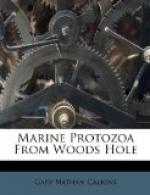Length 68 mu; diameter 54 mu. Common.
Although the description of Pouchet’s P. digitale differs in some respects from a careful description of the Woods Hole form, I think the species are the same. The chief difference is in the single horn of the posterior half; in Pouchet’s form this is furrowed by a narrow groove which runs to the S-shaped longitudinal furrow. In the Woods Hole form I was unable to make out such a furrow. The flagella, also, were not seen. This same form was pictured by Peck ’95 as P. divergens.
[Illustration: Fig. 23.—Peridinium digitale.]
Peridinium divergens Ehr. Fig. 24.
Synonym: Ceratium divergens Kent.
The shell is spheroidal, widest centrally, attenuate and pointed posteriorly; the anterior portion is armed with two short, pointed horns, each of them having a toothed process at the basal portion of the inner margin. They are frequently colorless and beautifully transparent, the body being free from large opaque granules; again they are colored brown or yellow. The nucleus is large and elongate and finely granular. 75 mu long and 68 mu in diameter. Common.
[Illustration: Fig. 24.—Ventral and dorsal aspects of Peridinium divergens.]
Genus CERATIUM (Schrank).
(Stein ’78; Perty ’52; Clap & Lach. ’58;
Bergh ’82; Pouchet ’83;
Gourret & Roeser ’88; Buetschli ’85; Kent
’81; Senn 1900; Schuett ’98.)
The general shape is a flattened sphere with three long processes or horns. The cross-furrow is either spiral or circular; the longitudinal furrow is usually wide and occupies the greater part of the anterior half of the shell. The shell is thick, reticulate or striped, and sometimes provided with short spines; often distinctly porous. The anterior half is composed of 3 equatorial and 3 apical plates, the latter being continued into the horn-like process. The posterior half is composed of 3 equatorial and one apical plate continued into the posterior horn. The right posterior plate is continued into a similar horn which may remain rudimentary or be continued into a considerable process. Similarly the left posterior horn is usually developed, but remains small. There may be from 2 to 3, 4, and 5 horns. Chromatophores usually present, green to yellow brown.
Fresh and salt water.
Ceratium tripos Ehr. Fig. 25.
The body is somewhat triangular and bears three horns, two of which are shorter than the other one and slightly curved upward.
Length, including the horns, 290 mu.
[Illustration: Fig. 25.—Ceratium tripos.]
Ceratium fusus Ehr. Fig. 26.
Synonym: Peridinium fusus Ehr.
The animal is very elongate, due to the presence of two long horns at the extremities of the body. Color, yellow with chromatophores. Length 285 mu; width 23 mu.
Both of these species are common in the tow and in the algae at the edge of the wharf. Both of them are mentioned by Peck in ’93 and ’95.




